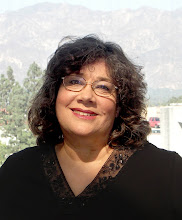
Petrea knew the where-are-we with her 8:36 a.m. Wednesday guess "The location is Central School, which was built in 1878 at the corner of Colorado and Fair Oaks," so I'm giving her the fabulous prize.
But nobody knew the what's-happening part.
In the photo above, people have gathered from far and wide in 1886 to bid on parcels that will be divided up from the five-acre Central School property.
The school, at left, was built in 1878 on the southeast corner of Colorado Street and Fair Oaks Avenue. Across the street are businesses under construction on Colorado Street.
To give you another perspective from a different angle, here's an earlier photo of the school showing the vastness of the property:

After the lots were auctioned off, the school was moved to Raymond Avenue at Green Street and a portion of it was leased to the newly incorporated City of Pasadena to serve as the City Hall.
Here it is in its new location, with civic leaders:

When the Indiana Colony was established in 1874, the intention was for it to be a mostly agricultural community.
But then a rail line was built from L.A. to Pasadena, followed by the completion of the Santa Fe Railroad's transcontinental route that went right through this community.

Advertisements were prevalent in every major newspaper in the east and midwest, luring people to Southern California so they could begin living the good life in year-round sunshine. With a price war among railroads, a person could ride from Kansas City to Los Angeles for as little as $8.
This marked the beginnings of a population explosion in Pasadena.
First there was the auction sale in 1885 of 20 acres at Colorado and Orange Grove owned by Dr. O.H. Conger, who divided the land into 84 lots for what became the area's first residential subdivision.
And then came the auction of the Central School property for what became a thriving business center.
Here's an excerpt from my favorite local reference book, "Pasadena: Historical and Personal" by J.W. Wood:
Then occurred the school lot sale, which gave the final impetus towards a real boom in prices and a boost for speculations which culminated in the great boom. Of course, no one was contemplating such a thing as a boom then; indeed, few knew the meaning of the word in Pasadena, but it was nevertheless smoldering and needed only some spectacular event to introduce it...Even Mr. Wood won a bid for a parcel. Here's an excerpt from a Los Angeles Times article:
...During that year that had passed, the village of Pasadena had grown like Jonah's gourd, and became a town of nearly 10,000. The boom had smitten it and was at its apogee.
...J.W. Wood paid $3,750 for 25 feet front on Colorado St. Mr. Wood intends to put up a good building upon the lot, which is a very valuable one for business purposes.The total amount received for the Central School lot sales was $44,772. Imagine what five acres in Old Pasadena would go for today!
A large portion of the proceeds were used for the construction of Benjamin D. Wilson School, including purchase of the land on North Marengo.
Many thanks to Pasadena Public Library and Pasadena Museum of History.

6 comments:
I love that you run this History Mystery feature every week! It's always so interesting... and I'm always blown away by how much people know about this city! I've lived here for a long time now, but I don't know nearly enough...
Close but no cigar, we used to say. But I get a cigar? How nice.
Kat, we're all learning together. Petrea, close enough -- I'm very flexible with my fabulous prizes!
That Petrea is such a show off. ;)
Oh Margaret, I know. But I'll share my secret with you: Google.
The Schoolhouse photo with all the children in front is a wall size photo mural in the Schoolhouse Garage on Fair Oaks. Obviously the garage is named for the continual reference to the "schoolhouse block". Great post, Ann!
Post a Comment